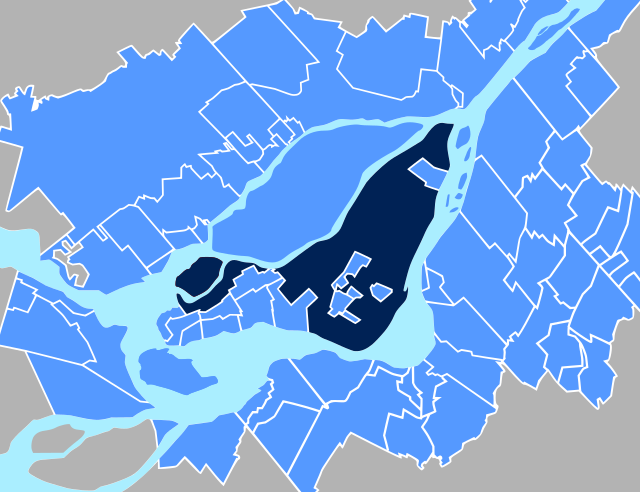Top Qs
Timeline
Chat
Perspective
Greater Montreal
Metropolitan area in Quebec, Canada From Wikipedia, the free encyclopedia
Remove ads
Greater Montreal (French: Grand Montréal, [ɡʁɑ̃ mɔ̃ʁeal]) is the most populous metropolitan area in Quebec and the second most populous in Canada after Greater Toronto. In 2015, Statistics Canada identified Montreal's Census Metropolitan Area (CMA) as 4,258.31 square kilometres (1,644.14 mi2) with a population of 4,027,100,[6] almost 50% of the province.
A smaller area of 3,838 square kilometres (1,482 mi2) is governed by the Montreal Metropolitan Community (MMC; French: Communauté métropolitaine de Montréal, CMM). This level of government is headed by a president (currently Montreal mayor Soraya Martinez Ferrada).
The inner ring is composed of densely populated municipalities located in close proximity to Downtown Montreal. It includes the entire Island of Montreal, Laval, and the Urban Agglomeration of Longueuil. Due to their proximity to Montreal's downtown core, some additional suburbs on the South Shore (Brossard, Saint-Lambert, and Boucherville) are usually included in the inner ring, despite their location on the mainland.
The outer ring is composed of low-density municipalities located on the fringe of Metropolitan Montreal. Most of these cities and towns are semi-rural. Specifically, the term banlieues hors de l'île (off-island suburbs) refers to those suburbs that are located on the North Shore of the Mille-Îles River, those on the South Shore that were never included in the megacity of Longueuil, and those on the Vaudreuil-Soulanges Peninsula.
Remove ads
Largest cities
Remove ads
Cities and towns
- Montreal
- Laval
- Longueuil


- subdivided into the boroughs of Le Vieux-Longueuil, Saint-Hubert and Greenfield Park.
Only a portion of the municipalities and MRC's located in geographical entities highlighted in light gray are part of the CMM/CMA.
There are 82 municipalities that are part of the MMC and 91 municipalities that are part of the CMA.
There are 79 municipalities that overlap between the two, with 3 municipalities being part of the MMC but not the CMA, and 12 municipalities being part of the CMA but not the MMC.[8][9]
Kanesatake and Kahnawake are not included in the previous counts.
Remove ads
Demographics
Ethnicity
- Note: Totals greater than 100% due to multiple origin responses.
Language
Remove ads
Transportation
Summarize
Perspective
Exo operates the region's commuter rail and metropolitan bus services, and is the second busiest such system in Canada after Toronto's GO Transit. Established in June 2007, Exo's commuter rail system has six lines linking the downtown core with communities as far west as Hudson, as Far south as Mont-Saint-Hilaire, as far east as Mascouche, and as far north as Saint-Jérôme.
Along with Exo, a sister agency, the Autorité régionale de transport métropolitain (ARTM) plans, integrates, and coordinates public transport across Greater Montreal, including the Island of Montreal, Laval (Île Jésus), and communities along both the north shore of the Rivière des Mille-Îles and the south shore of the Saint Lawrence River. The ARTM's mandate also includes the management of reserved High-occupancy vehicle lanes, metropolitan bus terminuses, park-and-ride lots, and a budget of $163 million, which is shared amongst the transit corporations and inter-municipal public transit organizations.
The Exo/ARTM's territory spans 63 municipalities and one native reserve, 13 regional county municipalities, and 21 transit authorities. It serves a population of approximately 3.7 million people who make more than 750,000 trips daily.[citation needed]
The major transit commissions under the ARTM are:
- Société de transport de Montréal (English: Montreal Transit Corporation), serving the Island of Montreal
- Société de transport de Laval (English: Laval Transit Corporation), serving the city of Laval
- Réseau de transport de Longueuil (English: Longueuil Transit Network), serving the Urban agglomeration of Longueuil
Remove ads
Education
Summarize
Perspective
(In Montreal, except where otherwise noted.)
Remove ads
See also
Notes
- 2001-2016: Statistic includes all persons that did not make up part of a visible minority or an indigenous identity.
2021: Statistic includes all persons belonging to the non-indigenous and non-visible minority "White" population group. - Statistic includes total responses of "West Asian" and "Arab" under visible minority section on census.
- Statistic includes total responses of "Chinese", "Korean", and "Japanese" under visible minority section on census.
- Statistic includes total responses of "Filipino" and "Southeast Asian" under visible minority section on census.
- Statistic includes total responses of "Visible minority, n.i.e." and "Multiple visible minorities" under visible minority section on census.
- Group 1
- Group 2
- classified as an equivalent territory
- Group 3
- in area served by the Réseau de transport métropolitain
Remove ads
References
External links
Wikiwand - on
Seamless Wikipedia browsing. On steroids.
Remove ads






